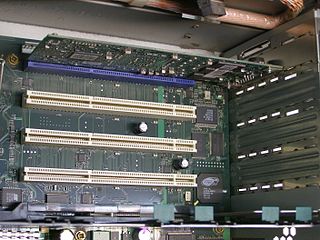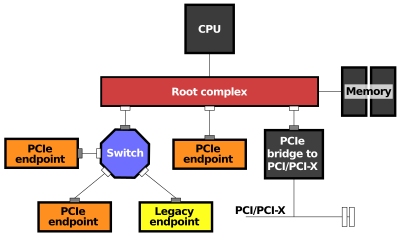
In computer architecture, a bus is a communication system that transfers data between components inside a computer, or between computers. This expression covers all related hardware components and software, including communication protocols.

Peripheral Component Interconnect (PCI) is a local computer bus for attaching hardware devices in a computer and is part of the PCI Local Bus standard. The PCI bus supports the functions found on a processor bus but in a standardized format that is independent of any given processor's native bus. Devices connected to the PCI bus appear to a bus master to be connected directly to its own bus and are assigned addresses in the processor's address space. It is a parallel bus, synchronous to a single bus clock. Attached devices can take either the form of an integrated circuit fitted onto the motherboard or an expansion card that fits into a slot. The PCI Local Bus was first implemented in IBM PC compatibles, where it displaced the combination of several slow Industry Standard Architecture (ISA) slots and one fast VESA Local Bus (VLB) slot as the bus configuration. It has subsequently been adopted for other computer types. Typical PCI cards used in PCs include: network cards, sound cards, modems, extra ports such as Universal Serial Bus (USB) or serial, TV tuner cards and hard disk drive host adapters. PCI video cards replaced ISA and VLB cards until rising bandwidth needs outgrew the abilities of PCI. The preferred interface for video cards then became Accelerated Graphics Port (AGP), a superset of PCI, before giving way to PCI Express.

In computing, an expansion card is a printed circuit board that can be inserted into an electrical connector, or expansion slot on a computer's motherboard to add functionality to a computer system. Sometimes the design of the computer's case and motherboard involves placing most of these slots onto a separate, removable card. Typically such cards are referred to as a riser card in part because they project upward from the board and allow expansion cards to be placed above and parallel to the motherboard.

PCI Express, officially abbreviated as PCIe or PCI-e, is a high-speed serial computer expansion bus standard, designed to replace the older PCI, PCI-X and AGP bus standards. It is the common motherboard interface for personal computers' graphics cards, sound cards, hard disk drive host adapters, SSDs, Wi-Fi and Ethernet hardware connections. PCIe has numerous improvements over the older standards, including higher maximum system bus throughput, lower I/O pin count and smaller physical footprint, better performance scaling for bus devices, a more detailed error detection and reporting mechanism, and native hot-swap functionality. More recent revisions of the PCIe standard provide hardware support for I/O virtualization.

The southbridge is one of the two chips in the core logic chipset on a personal computer (PC) motherboard, the other being the northbridge. The southbridge typically implements the slower capabilities of the motherboard in a northbridge/southbridge chipset computer architecture. In systems with Intel chipsets, the southbridge is named I/O Controller Hub (ICH), while AMD has named its southbridge Fusion Controller Hub (FCH) since the introduction of its Fusion Accelerated Processing Unit (APU) while moving the functions of the Northbridge onto the CPU die, hence making it similar in function to the Platform hub controller.

PCI-X, short for Peripheral Component Interconnect eXtended, is a computer bus and expansion card standard that enhances the 32-bit PCI local bus for higher bandwidth demanded mostly by servers and workstations. It uses a modified protocol to support higher clock speeds, but is otherwise similar in electrical implementation. PCI-X 2.0 added speeds up to 533 MHz, with a reduction in electrical signal levels.
PCI configuration space is the underlying way that the Conventional PCI, PCI-X and PCI Express perform auto configuration of the cards inserted into their bus.

The RapidIO architecture is a high-performance packet-switched electrical connection technology. RapidIO supports messaging, read/write and cache coherency semantics. Based on industry-standard electrical specifications such as those for Ethernet, RapidIO can be used as a chip-to-chip, board-to-board, and chassis-to-chassis interconnect.

PC/104 is a family of embedded computer standards which define both form factors and computer buses by the PC/104 Consortium. Its name derives from the 104 pins on the interboard connector (ISA) in the original PC/104 specification and has been retained in subsequent revisions, despite changes to connectors. PC/104 is intended for specialized environments where a small, rugged computer system is required. The standard is modular, and allows consumers to stack together boards from a variety of COTS manufacturers to produce a customized embedded system.
lspci is a command on Unix-like operating systems that prints ("lists") detailed information about all PCI buses and devices in the system. It is based on a common portable library libpci which offers access to the PCI configuration space on a variety of operating systems.

In computing, an input–output memory management unit (IOMMU) is a memory management unit (MMU) connecting a direct-memory-access–capable (DMA-capable) I/O bus to the main memory. Like a traditional MMU, which translates CPU-visible virtual addresses to physical addresses, the IOMMU maps device-visible virtual addresses to physical addresses. Some units also provide memory protection from faulty or malicious devices.
The AMD 700 chipset series is a set of chipsets designed by ATI for AMD Phenom processors to be sold under the AMD brand. Several members were launched in the end of 2007 and the first half of 2008, others launched throughout the rest of 2008.
Logical Domains is the server virtualization and partitioning technology for SPARC V9 processors. It was first released by Sun Microsystems in April 2007. After the Oracle acquisition of Sun in January 2010, the product has been re-branded as Oracle VM Server for SPARC from version 2.0 onwards.
eXtensible Host Controller Interface (xHCI) is a computer interface specification that defines a register-level description of a host controller for Universal Serial Bus (USB), which is capable of interfacing with USB 1.x, 2.0, and 3.x compatible devices. The specification is also referred to as the USB 3.0 host controller specification.

M.2, pronounced m dot two and formerly known as the Next Generation Form Factor (NGFF), is a specification for internally mounted computer expansion cards and associated connectors. M.2 replaces the mSATA standard, which uses the PCI Express Mini Card physical card layout and connectors. Employing a more flexible physical specification, M.2 allows different module widths and lengths, which, paired with the availability of more advanced interfacing features, makes M.2 more suitable than mSATA in general for solid-state storage applications, particularly in smaller devices such as ultrabooks and tablets.

SATA Express is a computer bus interface that supports both Serial ATA (SATA) and PCI Express (PCIe) storage devices, initially standardized in the SATA 3.2 specification. The SATA Express connector used on the host side is backward compatible with the standard SATA data connector, while it also provides two PCI Express lanes as a pure PCI Express connection to the storage device.

NVLink is a wire-based serial multi-lane near-range communications link developed by Nvidia. Unlike PCI Express, a device can consist of multiple NVLinks, and devices use mesh networking to communicate instead of a central hub. The protocol was first announced in March 2014 and uses a proprietary high-speed signaling interconnect (NVHS).
ExpEther is a System Hardware Virtualization Technology that expands standard PCI Express beyond 1 km having thousands of roots and endpoint devices together on a single network connected through the standard Ethernet. Abundant commodities of PCI Express-based software and hardware can be utilized without any modification. It also provides software-defined re-configurability to make a disaggregated computing system with device-level.
Compute Express Link (CXL) is an open standard for high-speed, high capacity central processing unit (CPU)-to-device and CPU-to-memory connections, designed for high performance data center computers. CXL is built on the serial PCI Express (PCIe) physical and electrical interface and includes PCIe-based block input/output protocol (CXL.io) and new cache-coherent protocols for accessing system memory (CXL.cache) and device memory (CXL.mem). The serial communication and pooling capabilities allows CXL memory to overcome performance and socket packaging limitations of common DIMM memory when implementing high storage capacities.












